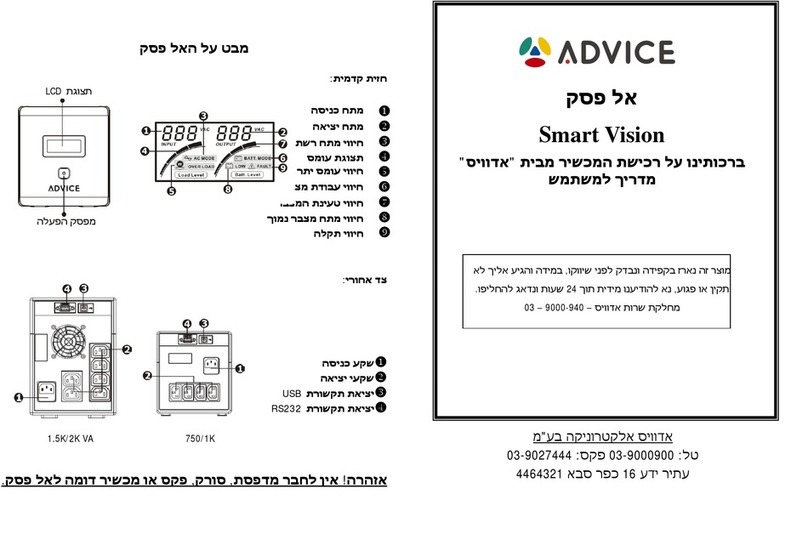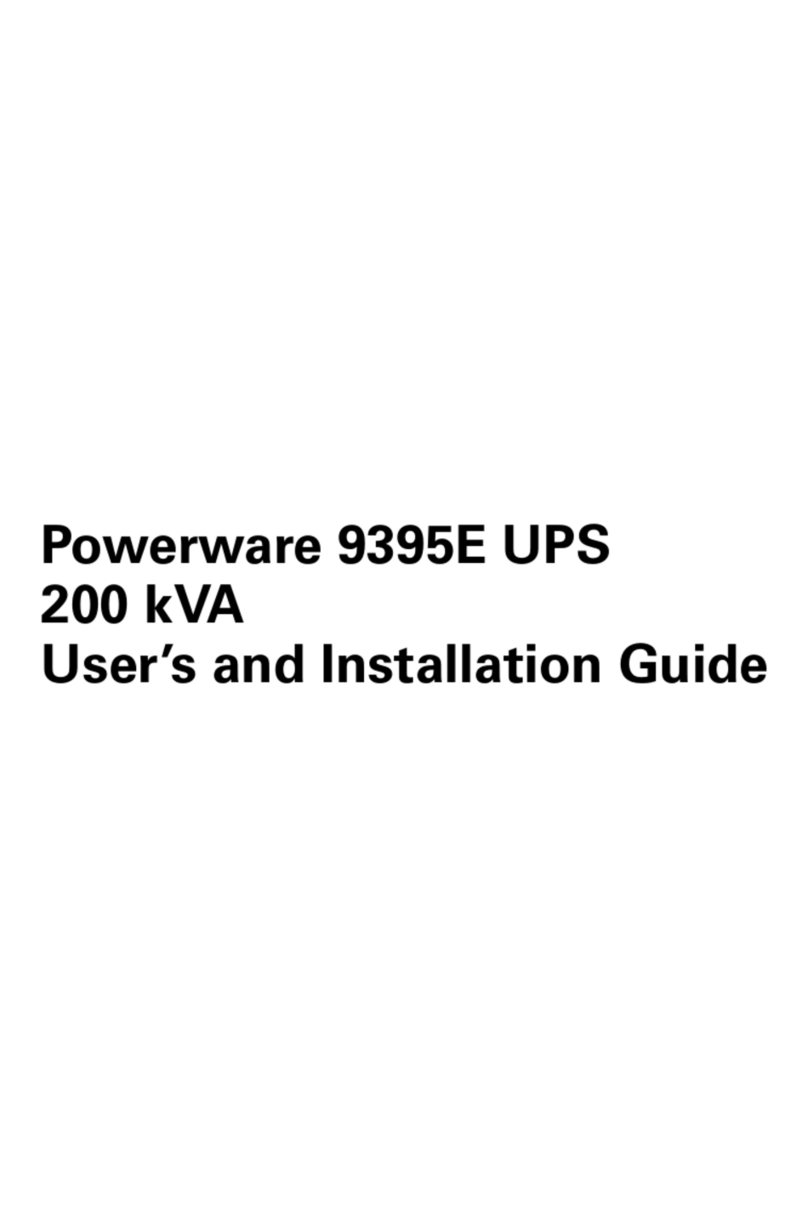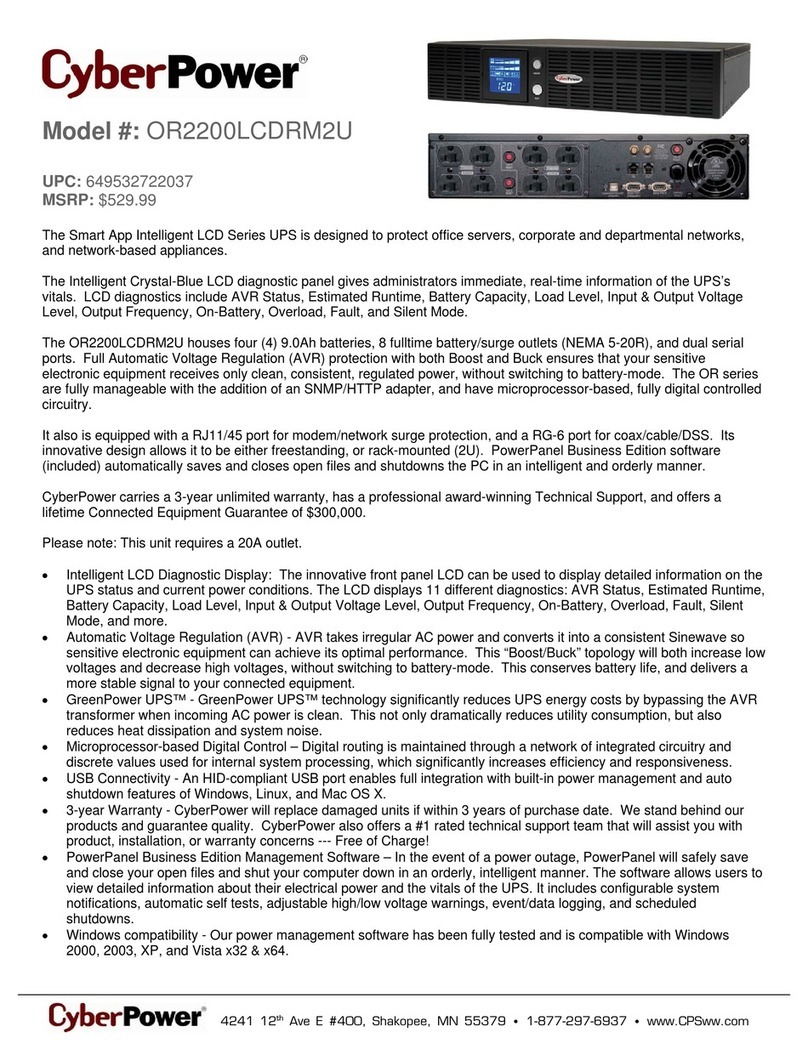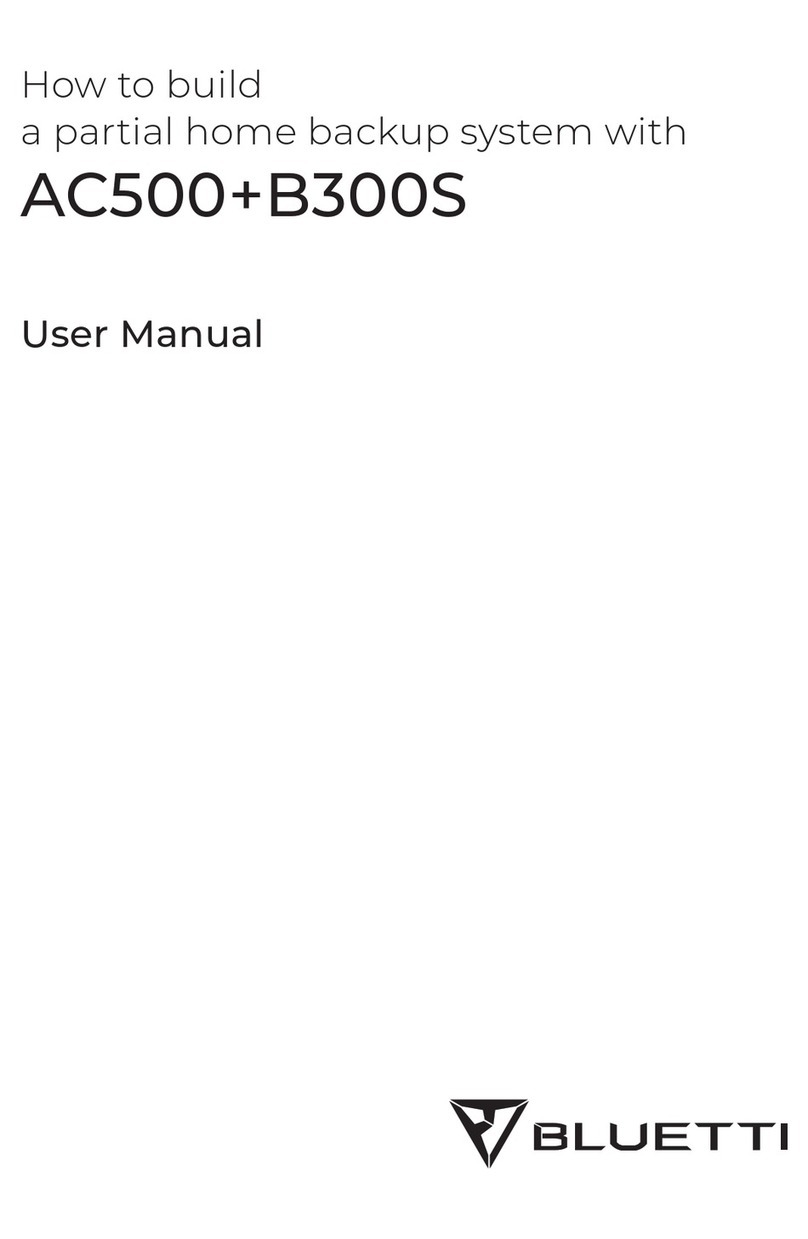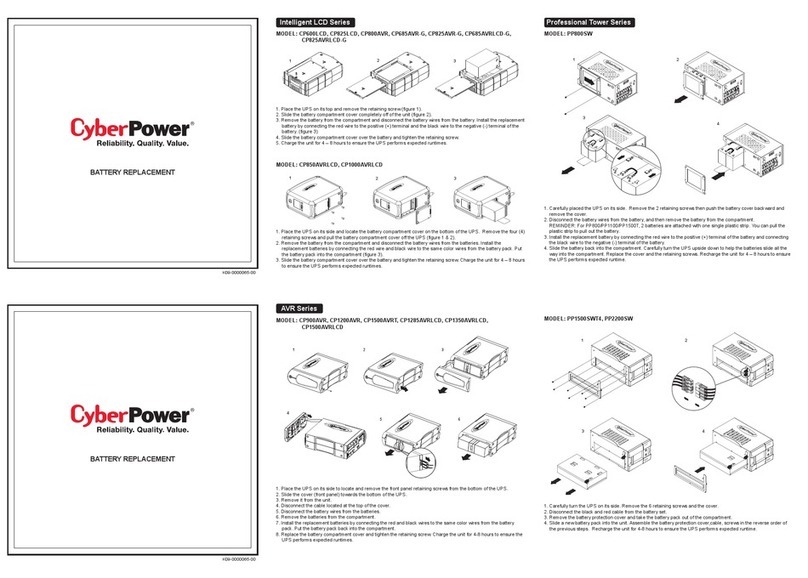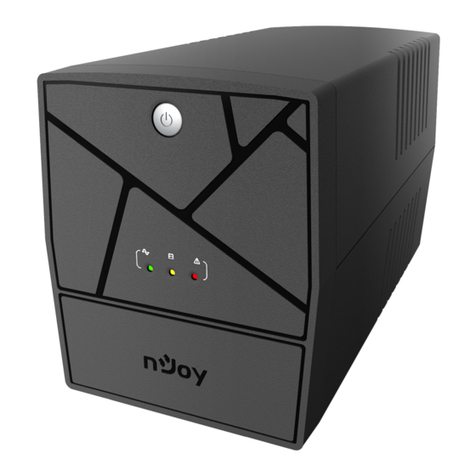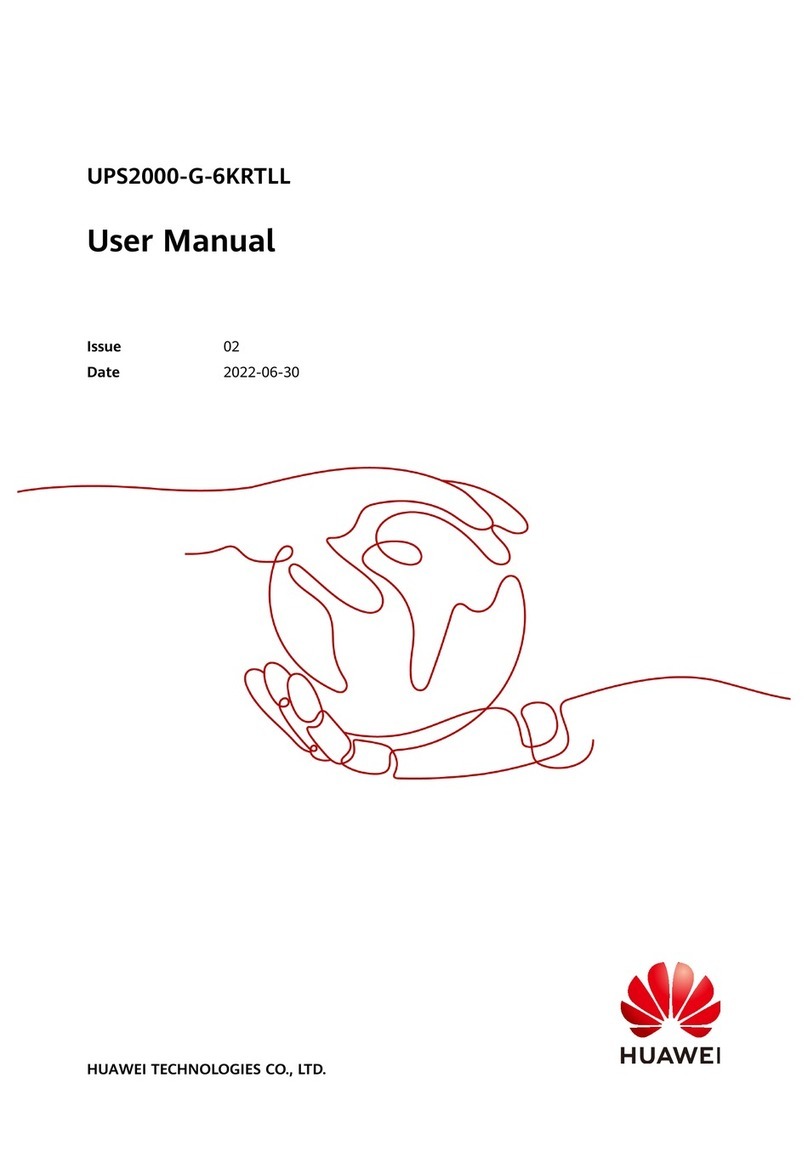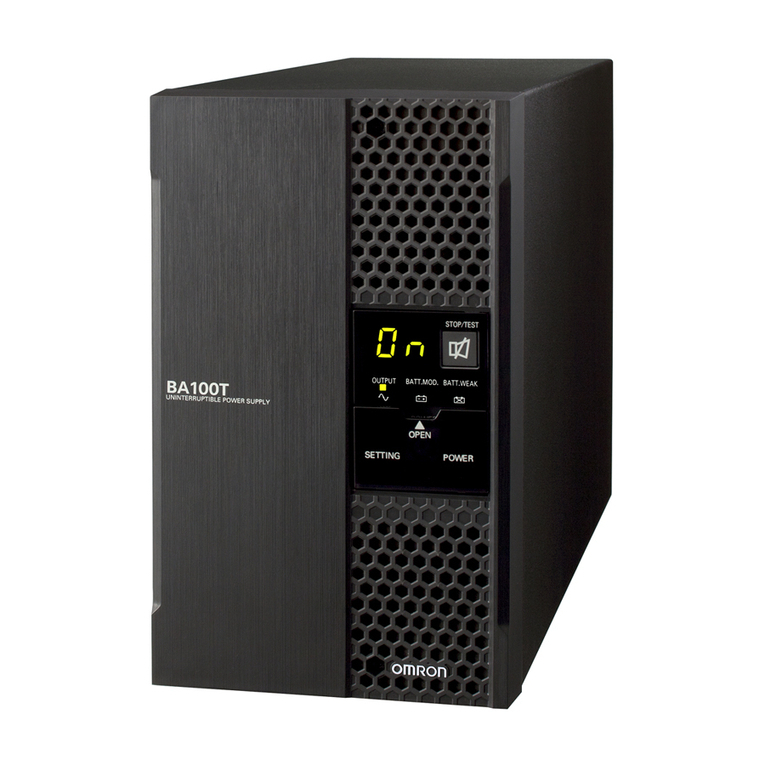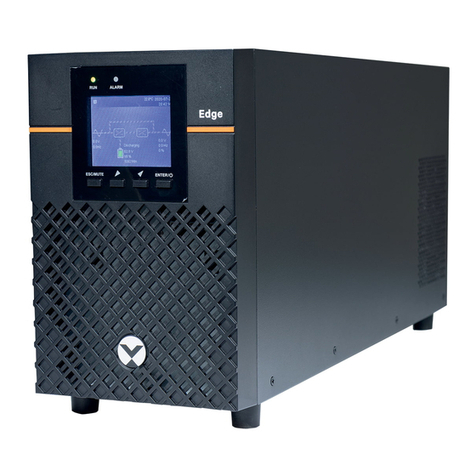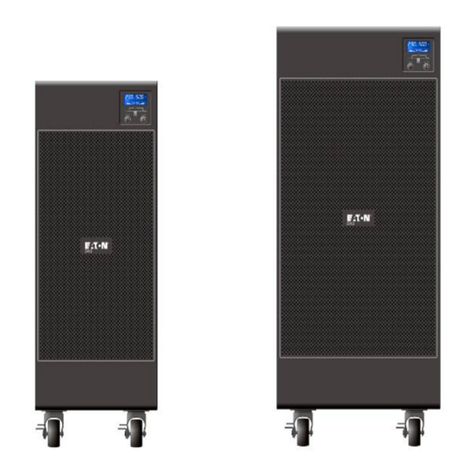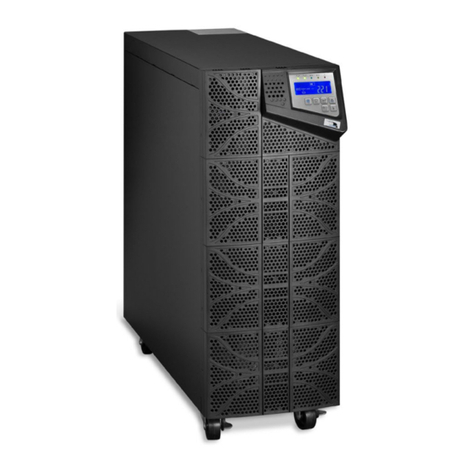Advice TOPV1000 User manual

Top Vision UPS
User Manual
TOPV1000/ TOPV 1500
TOPV 2000/ TOPV 3000
Online UPS
Uninterruptible Power Supply System

1
Table of Contents
1. Important Safety Warning
2
1-1. Transportation 2
1-2. Preparation 2
1-3. Installation 2
1-4. Operation 2
1-5. aintenance, service and faults 3
2. Installation and setup
4
2-1. Rear panel view 4
2-2. Setup the UPS 6
3. Operations ..
9
3-1. Button operation 9
3-2. LCD Panel 9
3-3. Audible Alarm 11
3-4. LCD display wordings index 11
3-5. UPS Setting 11
3-6. Operating ode Description 14
3-7. Faults Reference Code 14
3-8. Warning indicator 15
4. Troubleshooting ...
16
5. Storage and Maintenance .
18
6. Specifications 19

2
1. Important Safety Warning
Please comply with all warnings and operating instructions in this manual strictly. Save this
manual properly and read carefully the following instructions before installing the unit. Do
not operate this unit before reading through all safety information and operating
instructions carefully
1-1. Transportation
Please transport the UPS system only in the original package to protect against
shock and impact.
1-2. Preparation
Condensation may occur if the UPS system is moved directly from cold to warm
environment. The UPS system must be absolutely dry before being installed.
Please allow at least two hours for the UPS system to acclimate the environment.
Do not install the UPS system near water or in moist environments.
Do not install the UPS system where it would be exposed to direct sunlight or
near heater.
Do not block ventilation holes in the UPS housing.
1-3. Installation
Do not connect appliances or devices which would overload the UPS system (e.g.
laser printers) to the UPS output sockets.
Place cables in such a way that no one can step on or trip over them.
Do not connect domestic appliances such as hair dryers to UPS output sockets.
The UPS can be operated by any individuals with no previous experience.
Connect the UPS system only to an earthed shockproof outlet which must be
easily accessible and close to the UPS system.
Please use only VDE-tested, CE-marked mains cable (e.g. the mains cable of your
computer) to connect the UPS system to the building wiring outlet (shockproof
outlet).
Please use only VDE-tested, CE-marked power cables to connect the loads to the
UPS system.
When installing the equipment, it should ensure that the sum of the leakage
current of the UPS and the connected devices does not exceed 3.5mA.
1-4. Operation
Do not disconnect the mains cable on the UPS system or the building wiring
outlet (shockproof socket outlet) during operations since this would cancel the
protective earthing of the UPS system and of all connected loads.
The UPS system features its own, internal current source (batteries). The UPS
output sockets or output terminals block may be electrically live even if the UPS
system is not connected to the building wiring outlet.
In order to fully disconnect the UPS system, first press the OFF/Enter button to
disconnect the mains.
Prevent no fluids or other foreign objects from inside of the UPS system.

3
1-5. Maintenance, service and faults
The UPS system operates with hazardous voltages. Repairs may be carried out
only by qualified maintenance personnel.
Caution - risk of electric shock. Even after the unit is disconnected from the
mains (building wiring outlet), components inside the UPS system are still
connected to the battery and electrically live and dangerous.
Before carrying out any kind of service and/or maintenance, disconnect the
batteries and verify that no current is present and no hazardous voltage exists in
the terminals of high capability capacitor such as BUS-capacitors.
Only persons are adequately familiar with batteries and with the required
precautionary measures may replace batteries and supervise operations.
Unauthorized persons must be kept well away from the batteries.
Caution - risk of electric shock. The battery circuit is not isolated from the input
voltage. Hazardous voltages may occur between the battery terminals and the
ground. Before touching, please verify that no voltage is present!
Batteries may cause electric shock and have a high short-circuit current. Please
take the precautionary measures specified below and any other measures
necessary when working with batteries:
remove wristwatches, rings and other metal objects
use only tools with insulated grips and handles.
When changing batteries, install the same number and same type of batteries.
Do not attempt to dispose of batteries by burning them. This could cause battery
explosion.
Do not open or destroy batteries. Escaping electrolyte can cause injury to the
skin and eyes. It may be toxic.
Please replace the fuse only with the same type and amperage in order to avoid
fire hazards.
Do not dismantle the UPS system.

4
1000VA(L) 2000VA(L) TOWER 3000VA(L) TOWER
IEC Type
1000VA(L) / 1500VA(L)
RACKMOUNT 2000VA(L) RACKMOUNT 3000VA(L) RACKMOUNT
IEC Type
IEC Type
IEC Type
Programmable outlets: connect to non-critical loads.
1. Output receptacles: connect to mission-critical loads.
2. AC input
3. Input circuit breaker
4. Network/Fax/ odem surge protection
5. Emergency power off function connector (EPO)
6. USB communication port
7. RS-232 communication port
8. SN P intelligent slot
9. External battery connection (only available for L model)
10.Output terminal
11.Output circuit breaker
12.Input terminal

5
2-2. Setup the UPS
Step 1: UPS input connection
Plug the UPS into a two-pole, three-wire, grounded receptacle only. Avoid using extension
cords.
For 208/220/230/240VAC models:
The power cord is supplied in the UPS package.
For 110/115/120/127VAC models: The power cord is attached to the UPS. The input
plug is a NE A 5-15P for 1K, 1KL, 1.5K and 1.5KL models, NE A 5-20P for 2K and 2KL
models.
Note:
For Low voltage models
: Check if the site wiring fault indicator lights up in LCD
panel. It will be illuminated when the UPS is plugged into an improperly wired utility power
outlet (Refer to Troubleshooting section).
Step 2: UPS output connection
For socket-type outputs, there two kinds of outputs: programmable outlets and
general outlets. Please connect non-critical devices to the programmable outlets and
critical devices to the general outlets. During power failure, you may extend the
backup time to critical devices by setting shorter backup time for non-critical devices.
For terminal-type input or outputs, please follow below steps for the wiring
configuration:
a) Remove the small cover of the terminal block
b) Suggest using AWG14 or 2.1mm
2
power cords. Suggest using WG12-10 or
3.3mm
2
-5.3mm
2
power cords for NE A type.
c) Upon completion of the wiring configuration, please check whether the wires are
securely affixed.
d) Put the small cover back to the rear panel.
Step 3: Communication connection
Communication port:
USB port RS-232 port Intelligent slot
To allow for unattended UPS shutdown/start-up and status monitoring, connect the
communication cable one end to the USB/RS-232 port and the other to the communication
port of your PC. With the monitoring software installed, you can schedule UPS
shutdown/start-up and monitor UPS status through PC.
The UPS is equipped with intelligent slot perfect for either SN P or AS400 card. When
installing either SN P or AS400 card in the UPS, it will provide advanced communication
and monitoring options.
PS. USB port and RS-232 port can’t work at the same time.
Step 4: Network connection
Network/Fax/Phone surge port
Connect a single modem/phone/fax line into surge-protected “IN” outlet on the back panel
of the UPS unit. Connect from “OUT” outlet to the equipment with another
modem/fax/phone line cable.

6
3. Operations
3-1. Button operation
Button Function
ON/ ute Button
Turn on the UPS: Press and hold ON/ ute button for at least 2
seconds to turn on the UPS.
ute the alarm: After the UPS is turned on in battery mode, press
and hold this button for at least 5 seconds to disable or enable the
alarm system. But it’s not applied to the situations when warnings
or errors occur.
Down key: Press this button to display previous selection in UPS
setting mode.
Switch to UPS self-test mode: Press ON/ ute buttons
simultaneously for 5 seconds to enter UPS self-testing while in AC
mode, ECO mode, or converter mode.
OFF/Enter
Button
Turn off the UPS: Press and hold this button at least 2 seconds to
turn off the UPS in battery mode. UPS will be in standby mode
under power normal or transfer to Bypass mode if the Bypass
enable setting by pressing this button.
Confirm selection key: Press this button to confirm selection in
UPS setting mode.
Select Button
Switch LCD message: Press this button to change the LCD
message for input voltage, input frequency, battery voltage,
output voltage and output frequency. It will return back to default
display when pausing for 10 seconds.
Setting mode: Press and hold this button for 5 seconds to enter
UPS setting mode when UPS is off.
Up key: Press this button to display next selection in UPS setting
mode.
ON/ ute +
Select Button
Switch to bypass mode: When the main power is normal, press
ON/ ute and Select buttons simultaneously for 5 seconds. Then
UPS will enter to bypass mode. This action will be ineffective when
the input voltage is out of acceptable range.

7
3-2. LCD Panel
Display Function
Backup time information
Indicates the backup time in pie chart.
Indicates the backup time in numbers.
H: hours, : minute, S: second
Fault information
Indicates that the warning and fault occurs.
Indicates the warning and fault codes, and the codes are listed
in details in 3-5 section.
ute operation
Indicates that the UPS alarm is disabled.
Output & Battery voltage information
Indicates the output voltage, frequency or battery voltage.
Vac: output voltage, Vdc: battery voltage, Hz: frequency
Load information
Indicates the load level by 0-25%, 26-50%, 51-75%, and
76-100%.
Indicates overload.
Indicates the load or the UPS output is short circuit.
Programmable outlets information
Indicates that programmable management outlets are working.
ode operation information
Indicates the UPS connects to the mains.
Indicates the battery is working.
Indicates the bypass circuit is working.
Indicates the ECO mode is enabled.

8
Indicates the Inverter circuit is working.
Indicates the output is working.
Battery information
Indicates the Battery level by 0-25%, 26-50%, 51-75%, and
76-100%.
Indicates the battery is fault.
Indicates low battery level and low battery voltage.
Input & Battery voltage information
Indicates the input voltage or frequency or battery voltage.
Vac: Input voltage, Vdc: battery voltage, Hz: input frequency
3-3. Audible Alarm
Battery Mode Sounding every 4 seconds
Low Battery Sounding every second
Overload Sounding twice every second
Fault Continuously sounding
Bypass Mode Sounding every 10 seconds
3-4. LCD display wordings index
Abbreviation Display content eaning
ENA Enable
DIS Disable
ESC Escape
HLS High loss
LLS Low loss
BAT Battery
CF Converter
EP EPO
FA Fan
TP Temperature
CH Charger

9
3-5. UPS Setting
There are three parameters to set up the
UPS.
Parameter 1: It’s for program alternatives.
There are 8 programs to set up: output
voltage setting, frequency converter
enable/disable, output frequency setting,
ECO enable/disable, ECO voltage range
setting, Bypass enable/disable, Bypass
voltage range setting, programmable
outlets enable/disable, programmable
outlets setting and exit.
•01: Output voltage setting
Interface Setting
For 208/220/230/240 VAC models, you may choose the
following output voltage:
208: presents output voltage is 208Vac
220: presents output voltage is 220Vac
230: presents output voltage is 230Vac
240: presents output voltage is 240Vac
For 110/150/120/127 VAC models, you may choose the
following output voltage:
110: presents output voltage is 110Vac
115: presents output voltage is 115Vac
120: presents output voltage is 120Vac
127: presents output voltage is 127Vac
•02: Frequency Converter enable/disable
Interface Setting
CF ENA: converter mode enable
CF DIS: converter mode disable
•03: Output frequency setting
Interface Setting
You may set the initial frequency on battery mode:
BAT 50: presents output frequency is 50Hz
BAT 60: presents output frequency is 60Hz
If converter mode enable, you may choose the
following output frequency:
CF 50: presents output frequency is 50Hz
CF 60: presents output frequency is 60Hz
Parameter 1
Parameter Parameter 3

10
•04: ECO enable/disable
Interface Setting
ENA: ECO mode enable
DIS: ECO mode disable
•05: ECO voltage range setting
Interface Setting
Press the Down key or Up key to set the acceptable
high voltage point and acceptable low voltage point:
HLS: High loss voltage in ECO mode (For
208/220/230/240 VAC models, the setting range is
from +7V to +24V of the nominal voltage. For
110/115/120/127 VAC models, the setting range is
from +3V to +12V of the nominal voltage).
LLS: Low loss voltage in ECO mode (For
208/220/230/240 VAC models, the setting range is
from -7V to -24V of the nominal voltage. For
110/115/120/127 VAC models, the setting voltage is
from -3V to -12V of the nominal voltage)
•06: Bypass enable/disable when UPS is off
Interface Setting
ENA: Bypass enable
DIS: Bypass disable
•07: Bypass voltage range setting
Interface Setting
Press the Down key or Up key to set the acceptable
high voltage point and acceptable low voltage point:
HLS: Bypass high voltage point
LLS: Bypass low voltage point
For 208/220/230/240 VAC models:
230-264: setting the high voltage point from 220Vac to
264Vac
170-220: setting the low voltage point from 170Vac to
220Vac
For 110/115/120/127 VAC models:
120-140: setting the high voltage point from 120Vac to
140Vac
85-115: setting the low voltage point from 85Vac to
115Vac

11
•08: Programmable outlets enable/disable
Interface Setting
ENA: Programmable outlets enable
DIS: Programmable outlets disable
•09: Programmable outlets setting
Interface Setting
0-999: setting the backup time limits in minutes from
0-999 for programmable outlets which connect to
non-critical devices on battery mode.
•00: Exit setting

12
3-6. Operating Mode Description
Operating mode Description LCD display
Online mode When the input voltage is within
acceptable range, UPS will provide pure
and stable AC power to output. The UPS
will also charge the battery at online
mode.
ECO mode Energy saving mode:
When the input voltage is within voltage
regulation range, UPS will bypass voltage
to output for energy saving.
Frequency
Converter mode
When input frequency is within 40 Hz to
70 Hz, the UPS can be set at a constant
output frequency, 50 Hz or 60 Hz. The
UPS will still charge battery under this
mode.
Battery mode When the input voltage is beyond the
acceptable range or power failure and
alarm is sounding every 4 second, UPS
will backup power from battery.
Bypass mode When input voltage is within acceptable
range but UPS is overload, UPS will enter
bypass mode or bypass mode can be set
by front panel. Alarm is sounding every
10 second.
Standby mode UPS is powered off and no output supply
power, but still can charge batteries.
3-7. Faults Reference Code
Fault event Fault code
Icon Fault event Fault code
Icon
Bus start fail 01 x Inverter voltage Low 13 x
Bus over 02 x Inverter output short 14
Bus under 03 x Battery voltage too high
27
Bus unbalance 04 x Battery voltage too low 28
Inverter soft start fail 11 x Over temperature 41 x
Inverter voltage high 12 x Over load 43

13
3-8. Warning indicator
Warning Icon (flashing) Alarm
Low Battery Sounding every second
Overload Sounding twice every second
Battery is not connected Sounding every second
Over Charge
Sounding every second
Site wiring fault
Sounding every second
EPO enable Sounding every second
Fan Failure Sounding every second
Over temperature Sounding every second
Charger failure Sounding every second
Out of bypass voltage range Sounding every second

14
4. Troubleshooting
If the UPS system does not operate correctly, please solve the problem by using the table
below.
Symptom Possible cause Remedy
The AC input power is not
connected well.
Check if input power cord
firmly connected to the
mains.
No indication and alarm even
though the mains is normal.
The AC input is connected
to the UPS output.
Plug AC input power cord
to AC input correctly.
The icon and the warning
code flashing on LCD
display and alarm is sounding
every second.
EPO function is activated.
Set the circuit in closed
position to disable EPO
function.
The icon and flashing
on LCD display and alarm is
sounding every second.
Line and neutral
conductors of UPS input
are reversed.
Rotate mains power
socket by 180° and then
connect to UPS system.
The icon and flashing
on LCD display and alarm is
sounding every second.
The external or internal
battery is incorrectly
connected.
Check if all batteries are
connected well.
Fault code is shown as 27 and
the icon is lighting on
LCD display and alarm is
continuously sounding.
Battery voltage is too
high or the charger is
fault.
Contact your dealer.
Fault code is shown as 28 and
the icon is lighting on
LCD display and alarm is
continuously sounding.
Battery voltage is too low
or the charger is fault.
Contact your dealer.
UPS is overload Remove excess loads
from UPS output.
UPS is overloaded.
Devices connected to the
UPS are fed directly by
the electrical network via
the Bypass.
Remove excess loads
from UPS output.
The icon and is
flashing on LCD display and
alarm is sounding twice every
second.
After repetitive
overloads, the UPS is
locked in the Bypass
mode. Connected devices
are fed directly by the
mains.
Remove excess loads
from UPS output first.
Then shut down the UPS
and restart it.
Fault code is shown as 43 and
The icon is lighting on
LCD display and alarm is
continuously sounding.
The UPS shut down
automatically because of
overload at the UPS
output.
Remove excess loads
from UPS output and
restart it.
Fault code is shown as 14 and
the icon is lighting on
LCD display and alarm is
The UPS shut down
automatically because
short circuit occurs on the
Check output wiring and if
connected devices are in
short circuit status.

15
continuously sounding. UPS output.
Fault code is shown as 1, 2, 3, 4,
11, 12, 13 and 41 on LCD
display and alarm is
continuously sounding.
A UPS internal fault has
occurred. There are two
possible results:
1. The load is still
supplied, but directly
from AC power via
bypass.
2. The load is no longer
supplied by power.
Contact your dealer
Batteries are not fully
charged
Charge the batteries for
at least 5 hours and then
check capacity. If the
problem still persists,
consult your dealer.
Battery backup time is shorter
than nominal value
Batteries defect Contact your dealer to
replace the battery.
The icon and the warning
code flashing on LCD
display and alarm is sounding
every second.
Fan is locked or not
working
Check fans and notify
dealer!!

16
5. Storage and Maintenance
5-1. Operation
The UPS system contains no user-serviceable parts. If the battery service life (3~5
years at 25°C ambient temperature) has been exceeded, the batteries must be
replaced. In this case, please contact your dealer.
Storage
Before storing, charge the UPS 5 hours. Store the UPS covered and upright in a cool,
dry location. During storage, recharge the battery in accordance with the following
table:
Storage Temperature Recharge Frequency Charging Duration
-25°C - 40°C Every 3 months 1-2 hours
40°C - 45°C Every 2 months 1-2 hours
Be sure to deliver the spent battery to a recycling facility or ship it to your
dealer in the replacement battery packing material.

17
6. Specifications
Model TOPV1000 TOPV1500 TOPV2000 TOPV3000
CAPACITY* 1000 VA / 800 W
1500 VA / 1200 W
2000 VA / 1600 W
3000 VA / 2400 W
INPUT
Low Line Transfer 160 VAC / 140 VAC / 120 VAC / 110 VAC ± 5 %
( based on load percentage 100% - 80 % / 80 % - 70 % / 70 - 60 % / 60 % -
0)
Low Line Comeback 175 VAC ± 5 %
High Line Transfer 300 VAC ± 5 %
Voltage
Range
High Line Comeback 290 VAC ± 5 %
Frequency Range 40Hz ~ 70 Hz
Phase Single phase with ground
Power Factor 0.95
OUTPUT
Output voltage 208/220/230/240VAC
AC Voltage Regulation
(Batt. ode) ± 3%
Frequency Range
(Synchronized Range) 47.5 ~ 52.5 Hz or 57 ~ 63 Hz
Frequency Range (Batt. ode) 50 Hz ± 0.25 Hz or 60Hz ± 0.3 Hz
Overload
100%~110%: warning
110%-130%: sounding every 12 seconds
>130% : sounding every 1.5 seconds
Current Crest Ratio 3:1
Harmonic Distortion
3 % THD (Linear Load)
6 % THD (Non-linear Load)
4 % THD (Linear Load)
7 % THD (Non-linear Load)
AC ode to Batt. ode
Zero
Transfer
Time Inverter to Bypass 4 ms (Typical)
Waveform (Batt. ode) Pure Sinewave
EFFICIENCY
AC ode ~ 85% ~ 88%
Battery ode ~ 83%
BATTERY
Battery Type 12 V / 7 AH 12 V / 9 AH 12 V / 7 AH 12 V / 9 AH
Numbers 3 3 6 6
Recharge Time 4 hours recover to 90% capacity (Typical)
Charging Current 1.0 A(max.)
Standard
odel
Charging Voltage 41.0 VDC ± 1% 82.1 VDC ±1%
Battery Type &
Numbers Depending on the capacity of external batteries
Charging Current 4.0 A or 8.0 A(max.)
Long-run
odel
Charging Voltage 41.0 VDC ± 1% 82.1 VDC ±1%
PHYSICAL
Dimension, D X W X H
397 X 145 X 220 (mm) 421 X 190 X 318 (mm) Tower
Case Net Weight (kgs) 13 7 14 7 26 13 28 13
Dimension, D X W X H
420x438x88[2U] (mm) 580x438x133[3U] (mm) Rack
Case Net Weight (kgs) 16 10 17 10 29 17 31 17
ENVIRONMENT
Operation Humidity 20-90 % RH @ 0- 40°C (non-condensing)
Noise Level Less than 45dBA @ 1 eter
MANAGEMENT
Smart RS-232 or USB Supports Windows 98 SE/ E/NT 4.x/2000/2003/XP/Vista/2008
Optional SN P Power management from SN P manager and web browser
•Derate capacity to 60% of capacity in Frequency converter mode and to 80% when the output voltage is
adjusted to 208VAC.

18
למסה לע הציחל -
היצרוגיפנוקה ךסמ תא תחתופ:
ךירצךסמה םוליצ יפל הנכתה תא ןכדעל.
ןותחתה רותפכה לע ץוחלל ןכמ רחאל- APPLY
המסיס תשקבמ הנכותה . איה המסיסה :
administrator

19
המכ רחאלNextםיכסמו ,יפוס הנקתה ךסמ עיפוי:
הנקתהה רחאל ,למסה ךסמה תיתחתב עיפומ:
םע הנכותה תא םיחתופרבכעב םיימעפ הציחל
רבכעב ןימי דצ וא :Open Monitor
ישארה ךסמה עיפומו:
This manual suits for next models
3
Table of contents
Other Advice UPS manuals


